A Newly Synthesized Heterobimetallic NiII-GdIII Salamo-BDC-Based Coordination Polymer: Structural Characterization, DFT Calculation, Fluorescent and Antibacterial Properties
Abstract
:1. Introduction
2. Experimental Section
2.1. Materials and Physical Measurements
2.2. Preparation and Characterization of H2L
2.3. Preparation of the Coordination Polymer
2.4. X-ray Crystallography
3. Results and Discussion
3.1. Solubility and Molar Conductance
3.2. PXRD Analysis
3.3. FT-IR Spectra
3.4. UV-Vis Spectra
3.5. Crystal Structure Description
3.6. Fluorescence Properties
3.7. DFT Calculation
3.8. Antibacterial Activities
4. Conclusions
Author Contributions
Funding
Acknowledgments
Conflicts of Interest
References
- Akine, S.; Varadi, Z.; Nabeshima, T. Synthesis of planar metal complexes and the stacking abilities of naphthaenediol-based acyclic and macrocyclic salen-type ligands. Eur. J. Inorg. Chem. 2013, 35, 5987–5998. [Google Scholar] [CrossRef]
- Kang, Q.P.; Li, X.Y.; Wei, Z.L.; Zhang, Y.; Dong, W.K. Symmetric containing-PMBP N2O2-donors nickel (II) complexes: Syntheses, structures, Hirshfeld analyses and fluorescent properties. Polyhedron 2019, 165, 38–50. [Google Scholar] [CrossRef]
- Wu, H.L.; Bai, Y.C.; Zhang, Y.H.; Pan, G.L.; Kong, J.; Shi, F.; Wang, X.L. Two lanthanide (III) complexes based on the schiff base N, N-Bis (salicylidene)-1,5-diamino-3-oxapentane: Synthesis, characterization, DNA-binding properties, and antioxidation. Z. Anorg. Allg. Chem. 2014, 640, 2062–2071. [Google Scholar] [CrossRef]
- Kang, Q.P.; Li, X.Y.; Wang, L.; Zhang, Y.; Dong, W.K. Containing-PMBP N2O2-donors transition metal (II) complexes: Synthesis, crystal structure, Hirshfeld surface analyses and fluorescence properties. Appl. Organomet. Chem. 2019, 33, e5013. [Google Scholar] [CrossRef]
- Wu, H.L.; Bai, Y.C.; Zhang, Y.H.; Li, Z.; Wu, M.C.; Chen, C.Y.; Zhang, J.W. Synthesis, crystal structure, antioxidation and DNA-binding properties of a dinuclear copper (II) complex with bis (N-salicylidene)-3-oxapentane-1, 5-diamine. J. Coord. Chem. 2014, 67, 3054–3066. [Google Scholar] [CrossRef]
- Gao, L.; Wang, F.; Zhao, Q.; Zhang, Y.; Dong, W.K. Mononuclear Zn(II) and trinuclear Ni(II) complexes derived from a coumarin-containing N2O2 ligand: Syntheses, crystal structures and fluorescence properties. Polyhedron 2018, 139, 7–16. [Google Scholar] [CrossRef]
- Liu, Y.A.; Wang, C.Y.; Zhang, M.; Song, X.Q. Structures and magnetic properties of cyclic heterometallic tetranuclear clusters. Polyhedron 2017, 127, 278–286. [Google Scholar] [CrossRef]
- Liu, P.P.; Sheng, L.; Song, X.Q.; Xu, W.Y.; Liu, Y.A. Synthesis, structure and magnetic properties of a new one dimensional manganese coordination polymer constructed by a new asymmetrical ligand. Inorg. Chim. Acta 2015, 434, 252–257. [Google Scholar] [CrossRef]
- Song, X.Q.; Cheng, G.Q.; Liu, Y.A. Enhanced Tb (III) luminescence by d 10 transition metal coordination. Inorg. Chim. Acta 2016, 450, 386–394. [Google Scholar] [CrossRef]
- Wang, P.; Zhao, L. An infinite 2D supramolecular cobalt (II) complex based on an asymmetric salamo-type ligand: Synthesis, crystal structure, and spectral properties. Synth. React. Inorg. Met. -Org. Nano-Met. Chem. 2016, 46, 1095–1101. [Google Scholar] [CrossRef]
- Zhang, Y.; Liu, L.Z.; Peng, Y.D.; Li, N.; Dong, W.K. Structurally characterized trinuclear nickel (II) and copper (II) salamo-type complexes: Syntheses, Hirshfeld analyses and fluorescent properties Transit. Met. Chem. 2019, 44, 627–639. [Google Scholar] [CrossRef]
- Sun, Y.X.; Zhang, S.T.; Ren, Z.L.; Dong, X.Y.; Wang, L. Synthesis, characterization, and crystal structure of a new supramolecular CdII complex with halogen-substituted salen-type bisoxime. Synth. React. Inorg. Met.-Org. Nano-Met. Chem. 2013, 43, 995–1000. [Google Scholar] [CrossRef]
- Chattopadhyay, S.; Drew, M.G.B.; Ghosh, A. Methylene spacer-regulated structural variation in cobalt(II/III) complexes with bridging acetate and salen- or salpn-type Schiff-base ligands. Eur. J. Inorg. Chem. 2008, 10, 1693–1701. [Google Scholar] [CrossRef]
- Liu, L.Z.; Wang, L.; Yu, M.; Zhao, Q.; Zhang, Y.; Sun, Y.X.; Dong, W.K. A highly sensitive and selective fluorescent “off-on-off” relay chemosensor based on a new bis (salamo)-type tetraoxime for detecting Zn2+ and CN−. Spectrochim. Acta A 2019, 222, 7209. [Google Scholar] [CrossRef] [PubMed]
- Song, X.Q.; Peng, Y.J.; Chen, G.Q.; Wang, X.R.; Liu, P.P.; Xu, W.Y. Substituted group-directed assembly of Zn (II) coordination complexes based on two new structural related pyrazolone based salen ligands: Syntheses, structures and fluorescence properties. Inorg. Chim. Acta 2015, 427, 13–21. [Google Scholar] [CrossRef]
- Varga, Z.; Meana-Pañeda, R.; Song, G.L.; Paukku, Y.; Truhlar, D.G. Potential energy surface of triplet N2O2. J. Chem. Phys. 2016, 144, 8. [Google Scholar] [CrossRef]
- Zhao, Q.; An, X.X.; Liu, L.Z.; Dong, W.K. Syntheses, luminescences and Hirshfeld surfaces analyses of structurally characterized homo-trinuclear ZnII and hetero-pentanuclear ZnII-LnIII (Ln = Eu, Nd) bis(salamo)-like complexes. Inorg. Chim. Acta 2019, 490, 6–15. [Google Scholar] [CrossRef]
- Akine, S.; Utsuno, F.; Taniguchi, T.; Nabeshima, T. Dinuclear complexes of the N2O2 oxime chelate ligand with zinc(II)-lanthanide(III) as a selective sensitization system for Sm3+. Eur. J. Inorg. Chem. 2010, 20, 3143–3152. [Google Scholar] [CrossRef]
- Łępicka, K.; Pieta, P.; Francius, G.; Walcarius, A.; Kutner, W. Structure-reactivity requirements with respect to nickel-salen based polymers for enhanced electrochemical stability. Electrochim. Acta 2019, 315, 75–83. [Google Scholar] [CrossRef]
- Liu, X.; Manzurc, C.; Novoa, N.; Celedónc, S.; Carrilloc, D.; Hamon, J.R. Multidentate unsymmetrically substituted Schiff bases and their metal complexes: Synthesis, functional materials properties, and applications to catalysis. Coord. Chem. Rev. 2018, 357, 144–172. [Google Scholar] [CrossRef]
- Finelli, A.; Hérault, N.; Crochet, A.; Fromm, K.M. Threading salen-type Cu- and Ni-complexes into one-dimensional coordination polymers: Solution versus solid state, and the size effect of the alkali metal ion. Cryst. Growth Des. 2018, 18, 1215–1226. [Google Scholar] [CrossRef]
- Celedón, S.; Dorcet, V.; Roisnel, T.; Singh, A.; Ledoux-Rak, I.; Hamon, J.R.; Carrillo, D.; Manzur, C. Main-chain oligomers from NiII- and CuII-centered unsymmetrical N2O2 Schiff-base complexes: Synthesis and spectral, structural, and second-order nonlinear optical properties. Eur. J. Inorg. Chem. 2014, 29, 4984–4993. [Google Scholar]
- Akine, S. Novel ion recognition systems based on cyclic and acyclic oligo (salen)-type ligands. J. Incl. Phenom. Macrocycl. Chem. 2012, 72, 25–54. [Google Scholar] [CrossRef]
- Li, X.Y.; Chen, L.; Gao, L.; Zhang, Y.; Akogun, S.F.; Dong, W.K. Syntheses, crystal structures and catalytic activities of two solvent-induced homotrinuclear Co (II) complexes with a naphthalenediol-based bis(Salamo)-type tetraoxime ligand. RSC Adv. 2017, 7, 35905–35916. [Google Scholar] [CrossRef]
- Li, X.Y.; Kang, Q.P.; Liu, C.; Zhang, Y.; Dong, W.K. Structurally characterized homo-trinuclear ZnII and hetero- pentanuclear [ZnII4LnIII] complexes constructed from an octadentate bis(Salamo)-based ligand: Hirshfeld surfaces, fluorescence and catalytic properties. New J. Chem. 2019, 43, 4605–4619. [Google Scholar] [CrossRef]
- Wu, H.L.; Pan, G.L.; Bai, Y.C.; Zhang, Y.H.; Wang, H.; Shi, F.R.; Wang, X.L.; Kong, J. Study on synthesis, crystal structure, antioxidant and DNA-binding of mono-, di- and poly-nuclear lanthanides complexes with bis (N-salicylidene)-3-oxapentane-1,5-diamine. J. Photochem. Photobiol. B 2014, 135, 33–43. [Google Scholar] [CrossRef]
- Wu, H.L.; Pan, G.L.; Bai, Y.C.; Wang, H.; Kong, J.; Shi, F.R.; Zhang, Y.H.; Wang, X.L. Preparation, structure, DNA-binding properties, and antioxidant activities of a homodinuclear erbium (III) complex with a pentadentate Schiff base ligand. J. Chem. Res. 2014, 38, 211–217. [Google Scholar] [CrossRef]
- Wu, H.L.; Wang, C.P.; Wang, F.; Peng, H.P.; Zhang, H.; Bai, Y.C. A new manganese (III) complex from bis(5-methylsalicylaldehyde)-3-oxapentane-1,5-diamine: Synthesis, characterization, antioxidant activity and luminescence. J. Chin. Chem. Soc. 2015, 62, 1028–1034. [Google Scholar] [CrossRef]
- Song, X.Q.; Liu, P.P.; Liu, Y.A.; Zhou, J.J.; Wang, X.L. Two dodecanuclear heterometallic [Zn6Ln6] clusters constructed by a multidentate salicylamide salen-like ligand: Synthesis, structure, luminescence and magnetic properties. Dalton Trans. 2016, 45, 8154–8163. [Google Scholar] [CrossRef]
- Li, J.; Zhang, H.J.; Chang, J.; Jia, H.R.; Sun, Y.X.; Huang, Y.Q. Solvent-induced unsymmetric salamo-like trinuclear NiII complexes: Syntheses, crystal structures, fluorescent and magnetic properties. Crystals 2018, 8, 176. [Google Scholar] [CrossRef]
- Liu, P.P.; Wang, C.Y.; Zhang, M.; Song, X.Q. Pentanuclear sandwich-type ZnII-LnIII clusters based on a new Salen-like salicylamide ligand: Structure, near-infrared emission and magnetic properties. Polyhedron 2017, 129, 133–140. [Google Scholar] [CrossRef]
- Petrick, M.; Florian, B.; Katja, L.; Guntram, R.; Réne, P. Cooperative Al(Salen)-pyridinium catalysts for the asymmetric synthesis of trans-configured β-Lactones by [2+2]-cyclocondensation of acylbromides and aldehydes: Investigation of pyridinium substituent effects. Molecule 2012, 17, 7121–7150. [Google Scholar]
- Song, X.Q.; Liu, P.P.; Wang, C.Y.; Liu, Y.A.; Liu, W.S.; Zhang, M. Three sandwich-type zinc (II)-lanthanide (III) clusters: Structures, luminescence and magnetic properties. RSC Adv. 2017, 7, 22692–22698. [Google Scholar] [CrossRef] [Green Version]
- Chai, L.Q.; Huang, J.J.; Zhang, H.S. An unexpected cobalt (III) complex containing a Schiff base ligand: Synthesis, crystal structure, spectroscopic behavior, electrochemical property and SOD-like activity. Spectrochim. Acta A 2014, 131, 526–530. [Google Scholar] [CrossRef] [PubMed]
- Chai, L.Q.; Tang, L.J.; Chen, L.C.; Huang, J.J. Structural, spectral, electrochemical and DFT studies of two mononuclear manganese (II) and zinc (II) complexes. Polyhedron 2017, 122, 228–240. [Google Scholar] [CrossRef]
- Chai, L.Q.; Huang, J.J.; Zhang, J.Y.; Li, Y.X. Two 1-D and 2-D cobalt (II) complexes: Synthesis, crystal structures, spectroscopic and electrochemical properties. J. Coord. Chem. 2015, 68, 1224–1237. [Google Scholar] [CrossRef]
- Chai, L.Q.; Li, Y.X.; Chen, L.C.; Zhang, J.Y.; Huang, J.J. Synthesis, X-ray structure, spectroscopic, electrochemical properties and DFT calculation of a bridged dinuclear copper(II) complex. Inorg. Chim. Acta 2016, 444, 193–201. [Google Scholar] [CrossRef]
- Bhowmik, P.; Nayek, H.P.; Corbella, M.; Aliaga-Alcalde, N.; Chattopadhyay, S. Control of molecular architecture by steric factors: Mononuclear vs polynuclear manganese (III) compounds with tetradentate N2O2 donor Schiff bases. Dalton Trans. 2011, 40, 7916–7926. [Google Scholar] [CrossRef]
- Dong, W.K.; Ma, J.C.; Zhu, L.C.; Zhang, Y. Self-assembled zinc (II)-lanthanide (III) heteromultinuclear complexes constructed from 3-MeO salamo ligand: Syntheses, structures and luminescent properties. Cryst. Growth Des. 2016, 16, 6903–6914. [Google Scholar] [CrossRef]
- Dong, X.Y.; Kang, Q.P.; Li, X.Y.; Ma, J.C.; Dong, W.K. Structurally characterized solvent-induced homotrinuclear cobalt (II) N2O2-donor bisoxime-type complexes. Crystals 2018, 8, 139. [Google Scholar] [CrossRef] [Green Version]
- Novozhilova, M.V.; Smirnova, E.A.; Polozhentseva, J.A.; Danilova, J.A.; Chepurnaya, I.A.; Karushev, M.P.; Malev, V.V.; Timonov, A.M. Multielectron redox processes in polymeric cobalt complexes with N2O2 Schiff base ligands. Electrochim. Acta 2018, 282, 105–115. [Google Scholar] [CrossRef]
- Zhao, L.; Dang, X.T.; Chen, Q.; Zhao, J.X.; Wang, L. Synthesis, crystal structure and spectral properties of a 2D supramolecular copper (II) complex with 1-(4-{[(E)-3-ethoxyl-2-hydroxybenzylidene]amino}phenyl)ethanone oxime. Synth. React. Inorg. Met.-Org. Nano-Met. Chem. 2013, 43, 1241–1246. [Google Scholar] [CrossRef]
- Yamamura, M.; Takizawa, H.; Sakamoto, N.; Nabeshima, T. Monomeric and dimeric red/NIR-fluorescent dipyrrin-germanium complexes: Facile monomer-dimer interconversion driven by acid/base additions. Tetrahedron Lett. 2013, 54, 7049–7052. [Google Scholar] [CrossRef]
- Manna, A.K.; Mondal, J.; Chandra, R.; Rout, K.; Patra, G.K. A fluorescent colorimetric azo dye based chemosensor for detection of S2- in perfect aqueous solution and its applications in real sample analysis and molecular logic gate. Sens. Actuators B 2018, 10, 2317–2326. [Google Scholar] [CrossRef]
- Zhou, L.; Cai, P.; Fen, Y.; Cheng, J.; Xiang, H.; Liu, J.; Wu, D.; Zhou, X. Synthesis and photophysical properties of water-soluble sulfonato-Salen-type Schiff bases and their applications of fluorescence sensors for Cu2+ in water and living cells. Anal. Chim. Acta 2012, 735, 96–106. [Google Scholar] [CrossRef] [PubMed]
- Pushkarev, A.P.; Balashova, T.V.; Kukinov, A.A.; Arsenyev, M.V.; Yablonskiy, A.N.; Kryzhkov, D.I.; Andreev, B.A.; Rumyantcev, R.V.; Fukin, G.K.; Bochkarev, M.N. Sensitization of NIR luminescence of Yb3+ by Zn2+ chromophores in heterometallic complexes with a bridging Schiff-base ligand. Dalton Trans. 2017, 46, 10408–10417. [Google Scholar] [CrossRef] [PubMed] [Green Version]
- Peng, Y.D.; Li, X.Y.; Kang, Q.P.; An, G.X.; Zhang, Y.; Dong, W.K. Synthesis and fluorescence properties of asymmetrical salamo-type tetranuclear zinc (II) complex. Crystals 2018, 8, 107. [Google Scholar] [CrossRef] [Green Version]
- Peng, Y.D.; Wang, F.; Gao, L.; Dong, W.K. Structurally characterized dinuclear zinc (lI) bis(salamo)-type tetraoxime complex possessing square pyramidal and trigonal bipyramidal geometries. J. Chin. Chem. Soc. 2018, 65, 893–899. [Google Scholar] [CrossRef]
- Wang, F.; Liu, L.Z.; Gao, L.; Dong, W.K. Unusual constructions of two salamo-based copper (Il) complexes. Spectrochim. Acta A 2018, 203, 56–64. [Google Scholar] [CrossRef]
- Li, X.Y.; Kang, Q.P.; Liu, L.Z. Trinuclear Co (II) and mononuclear Ni (II) salamo-type bisoxime coordination compounds. Crystals 2018, 8, 43. [Google Scholar] [CrossRef] [Green Version]
- Dong, X.Y.; Zhao, Q.; Wei, Z.L.; Mu, H.R.; Zhang, H.; Dong, W.K. Synthesis and fluorescence propertiesof structurally characterized heterobimetalic Cu (II)-Na (I) bis (salamo)-based complex bearing square planar, square pyramid and triangular prism geometries of metal centers. Molecules 2018, 23, 1006. [Google Scholar] [CrossRef] [PubMed] [Green Version]
- Gao, L.; Liu, C.; Wang, F.; Dong, W.K. Tetra-, penta- and hexa-coordinated transition metal complexes constructedfrom coumarin-containing N2O2 ligand. Crystals 2018, 8, 77. [Google Scholar] [CrossRef] [Green Version]
- Wang, L.; Kang, Q.P.; Hao, J.; Dong, W.K. Two trinuclear cobalt(Il) salamo-type complexes: Syntheses, crystal structures, solvent effect and fluorescent properties. Chin. J. Inorg. Chem. 2018, 34, 525–533. [Google Scholar]
- Kang, Q.P.; Li, X.Y.; Zhao, Q.; Ma, J.C.; Dong, W.K. Structurally characterized homotrinuclear Salamo-type nickel (lI) complexes: Synthesis, solvent effect and fluorescence properties. Appl. Organomet. Chem. 2018, 32, e4379. [Google Scholar] [CrossRef]
- Hao, J.; Li, X.Y.; Zhang, Y.; Dong, W.K. A reversible bis(salamo)-based fluorescence sensor for selective detection of Cd2+ in water-containing systems and food samples. Materials 2018, 11, 523. [Google Scholar] [CrossRef] [Green Version]
- Zhang, L.W.; Li, X.Y.; Kang, Q.P. Liu, L.Z. Ma, J.C. Dong, W.K. Structures and fluorescent and magnetic behaviors of newly synthesized NiII and CuII coordination compounds. Crystals 2018, 8, 173. [Google Scholar] [CrossRef] [Green Version]
- Ren, Z.L.; Hao, J.; Hao, P.; Dong, X.Y.; Bai, Y.; Dong, W.K. Synthesis, crystal structure, luminescence and electrochemical properties of a salamo-type trinuclear cobalt (II) complex. Z. Nat. B 2018, 73, 203–210. [Google Scholar] [CrossRef]
- Zhang, L.W.; Liu, L.Z.; Wang, F.; Dong, W.K. Unprecedented fluorescent dinuclear CoII and ZnII coordination compounds with a symmetric bis(salamo)-like tetraoxime. Molecules 2018, 23, 1141. [Google Scholar] [CrossRef] [Green Version]
- Gulzhian, I.D.; Igor E, U. Design and synthesis of coordination polymers with chelated units and their application in nanomaterials science. RSC Adv. 2017, 7, 42242–42288. [Google Scholar]
- Yang, Y.H.; Zhang, Y.; Yu, M.; Zheng, S.S.; Dong, W.K. Heterbimetallic Cu (II)-Nd (III) and Zn (II)-Ce (III) salamo-type complexes: Syntheses, crystal structure and fluorescence properties. Chin. J. Inorg. Chem. 2018, 34, 997–1006. [Google Scholar]
- Akine, S.; Taniguchi, T.; Dong, W.K.; Masubuchi, S.; Nabeshima, T. Oxime-based salen-type tetradentate ligands with high stability against imine metathesis reaction. J. Org. Chem. 2005, 70, 1704–1711. [Google Scholar] [CrossRef] [PubMed]
- Sheldrick, G.M. Acta Crystallogr. Sect. C: Cryst. Struct. Commun. 2015, 71, 3–8. [Google Scholar]
- Geary, W.J. The use of conductivity measurements in organic solvents for the characterization of coordination compounds. Coord. Chem. Rev. 1971, 7, 81–122. [Google Scholar] [CrossRef]
- Dong, W.K.; Ma, J.C.; Zhu, L.C.; Zhang, Y. Nine self–assembled nickel (II)-lanthanide (III) heterometallic complexes constructed from a salamo–type bisoxime and bearing N– or –donor auxiliary ligand: Syntheses, structures and magnetic properties. New J. Chem. 2016, 40, 6998–7010. [Google Scholar] [CrossRef]
- Sun, Y.X.; Xu, L.; Zhao, T.H.; Liu, S.H.; Liu, G.H.; Dong, X.T. Synthesis and crystal structure of a 3D supramolecular copper (II) complex with 1-(3-{[(E)-3-bromo-5-chloro-2-hydroxybenzylidene]amino}phenyl) ethanone oxime. Synth. React. Inorg. Met. -Org. Nano-Met. Chem. 2013, 43, 509–513. [Google Scholar] [CrossRef]
- An, X.X.; Zhao, Q.; Mu, H.R.; Dong, W.K. A new half-salamo-based homo-trinuclear nickel (II) complex: Crystal structure, Hirshfeld surface analysis, and fluorescence properties. Crystals 2019, 9, 101. [Google Scholar] [CrossRef] [Green Version]
- Sun, Y.X.; Gao, X.H. Synthesis, characterization, and crystal structure of a new CuII complex with salen-type ligand. Synth. React. Inorg. Met. -Org. Nano-Met. Chem. 2011, 41, 973–978. [Google Scholar] [CrossRef]
- Wang, P.; Zhao, L. Synthesis, structure and spectroscopic properties of the trinuclear cobalt (II) and nickel (II) complexes based on 2-hydroxynaphthaldehyde and bis (aminooxy)alkane. Spectrochim. Acta A 2015, 135, 342–350. [Google Scholar] [CrossRef]
- Sun, Y.X.; Wang, L.; Dong, X.Y.; Ren, Z.L.; Meng, W.S. Synthesis, characterization, and crystal structure of a supramolecular CoII complex containing salen-type bisoxime. Synth. React. Inorg. Met.-Org. Nano-Met. Chem. 2013, 43, 599–603. [Google Scholar] [CrossRef]
- Chai, L.Q.; Liu, G.; Zhang, Y.L.; Huang, J.J.; Tong, J.F. Synthesis, crystal structure, fluorescence, electrochemical property, and SOD-like activity of an unexpected nickel (II) complex with a quinazoline-type ligand. J. Coord. Chem. 2013, 66, 3926–3938. [Google Scholar] [CrossRef]
- Jia, H.R.; Chang, J.; Zhang, H.J.; Li, J.; Sun, Y.X. Three polyhydroxyl-bridged defective dicubane tetranuclear MnIII complexes: Synthesis, crystal structures, and spectroscopic properties. Crystals 2018, 8, 272. [Google Scholar] [CrossRef] [Green Version]
- Wu, H.L.; Bai, Y.; Yuan, J.K.; Wang, H.; Pan, G.L.; Fan, X.Y.; Kong, J. A zinc (II) complex with tris (2-(N-methyl) benzimidazlylmethyl) amine and salicylate: Synthesis, crystal structure, and DNA-binding. J. Coord. Chem. 2012, 65, 2839–2851. [Google Scholar] [CrossRef]
- Wu, H.L.; Pan, G.L.; Bai, Y.C.; Wang, H.; Kong, J. Synthesis, structure, antioxidation, and DNA-bindingstudies of a binuclear ytterbium (III) complex with bis(N-salicylidene)-3-oxapentane-1,5-diamine. Res. Chem. Intermed. 2015, 41, 3375–3388. [Google Scholar] [CrossRef]
- Zheng, S.S.; Dong, W.K.; Zhang, Y.; Chen, L.; Ding, Y.J. Four salamo-type 3d-4f hetero-bimetallic [ZnIILnIII] complexes: Syntheses, crystal structures, and luminescent and magnetic properties. New J. Chem. 2017, 44, 4966–4973. [Google Scholar] [CrossRef]
- Chai, L.Q.; Hu, Q.; Zhang, K.Y.; Zhou, L.; Huang, J.J. Synthesis, structural characterization, spectroscopic, and DFT studies of two pentacoordinated zinc (II) complexes containing quinazoline and 1, 10-phenanthroline as mixed ligands. J. Lumin. 2018, 203, 234–246. [Google Scholar] [CrossRef]
- Purkayastha, A.; Debnath, D.; Majumder, M.; Ortega-Castro, J.; Kirillov, A.M.; Ganguly, R.; Misra, T.K. Nickel (II) based homo- vs heterometallic 1D coordination polymers derived from a novel 6-aminouracil building block: Structures, topologies, non-covalent interactions, magnetism, and antibacterial activity. Inorg. Chim. Acta 2018, 482, 384–394. [Google Scholar] [CrossRef]
- Tabong, C.D.; Yufanyi, D.M.; Paboudam, A.G.; Nono, K.N.; Eni, D.B.; Agwara, M.O. Synthesis, crystal structure, and antimicrobial properties of [diaquabis(hexamethylenetetramine)diisothiocyanato-κN]nickel (II) complex. Adv. Chem. 2016, 1–8. [Google Scholar] [CrossRef] [Green Version]
- Colinas, I.R.; Rojas-Andrade, M.D.; Chakraborty, I.; Oliver, S.R.J. Two structurally diverse Zn-based coordination polymers with excellent antibacterial activity. CrystEngComm 2018, 20, 3353–3362. [Google Scholar] [CrossRef]
- Rauf, A.; Ye, J.; Zhang, S.; Shi, L.; Akram, M.A.; Ning, G. Synthesis, structure and antibacterial activity of a copper (II) coordination polymer based on thiophene-2,5-dicarboxylate ligand. Polyhedron 2019, 166, 130–136. [Google Scholar] [CrossRef]



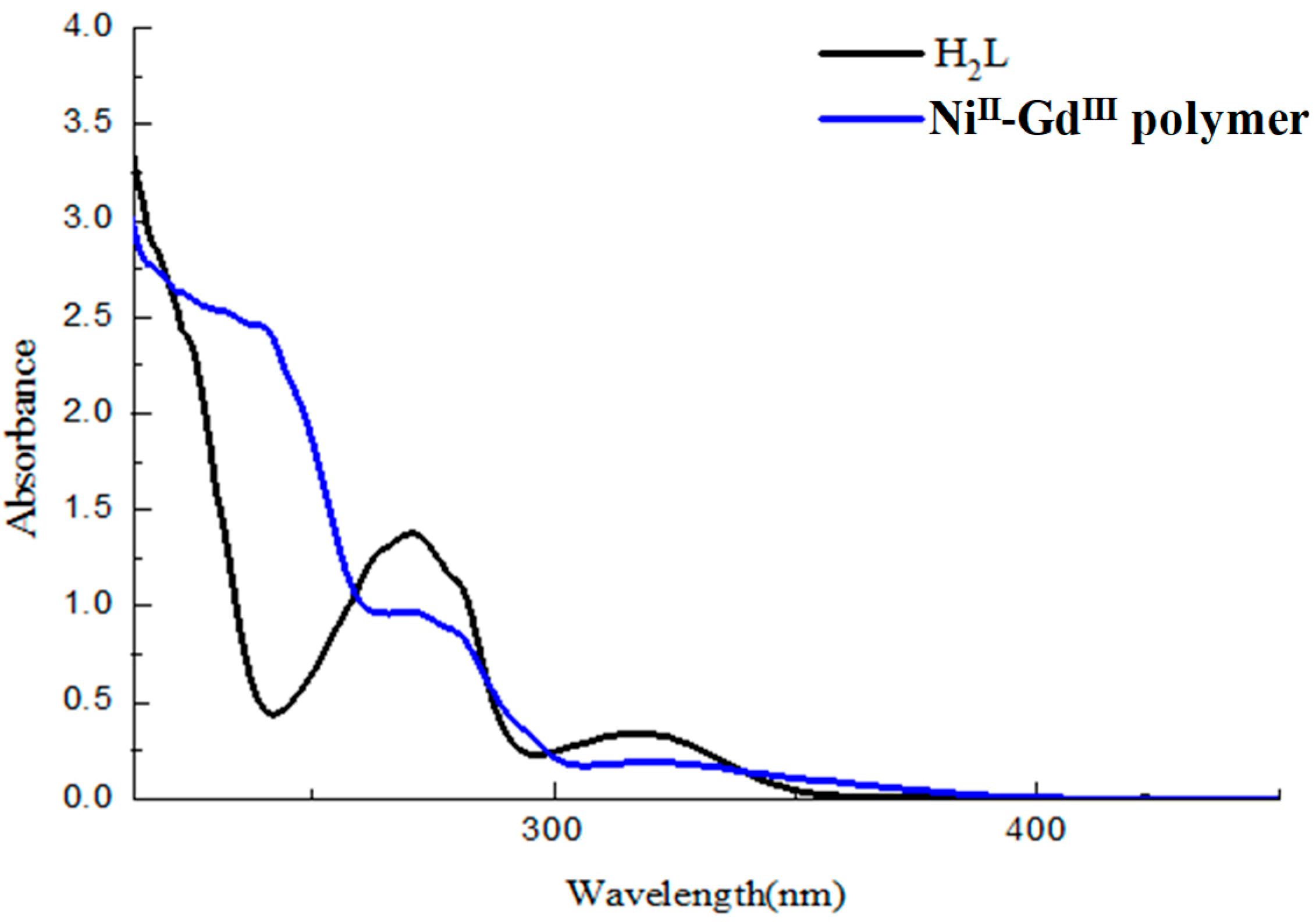
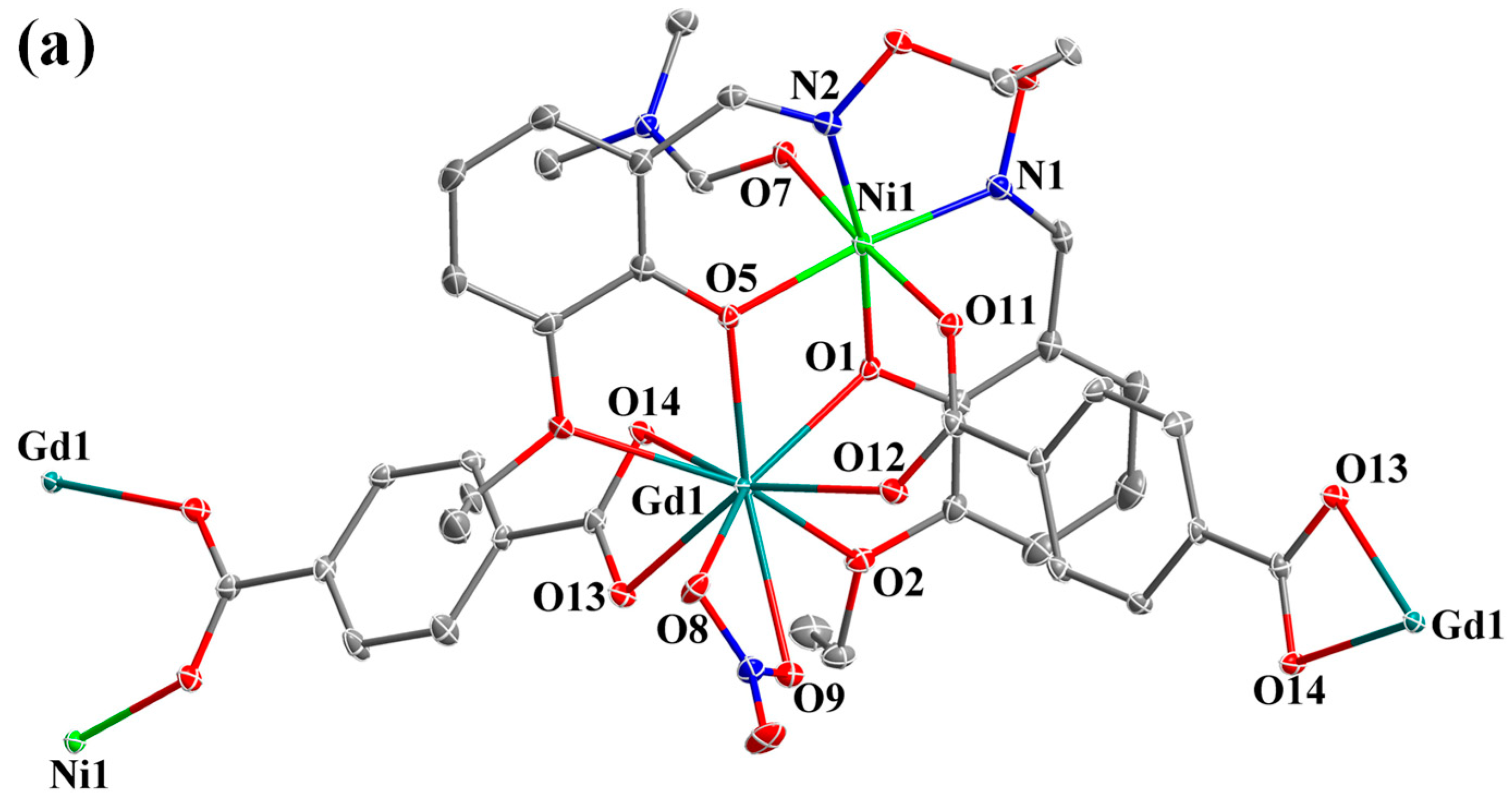

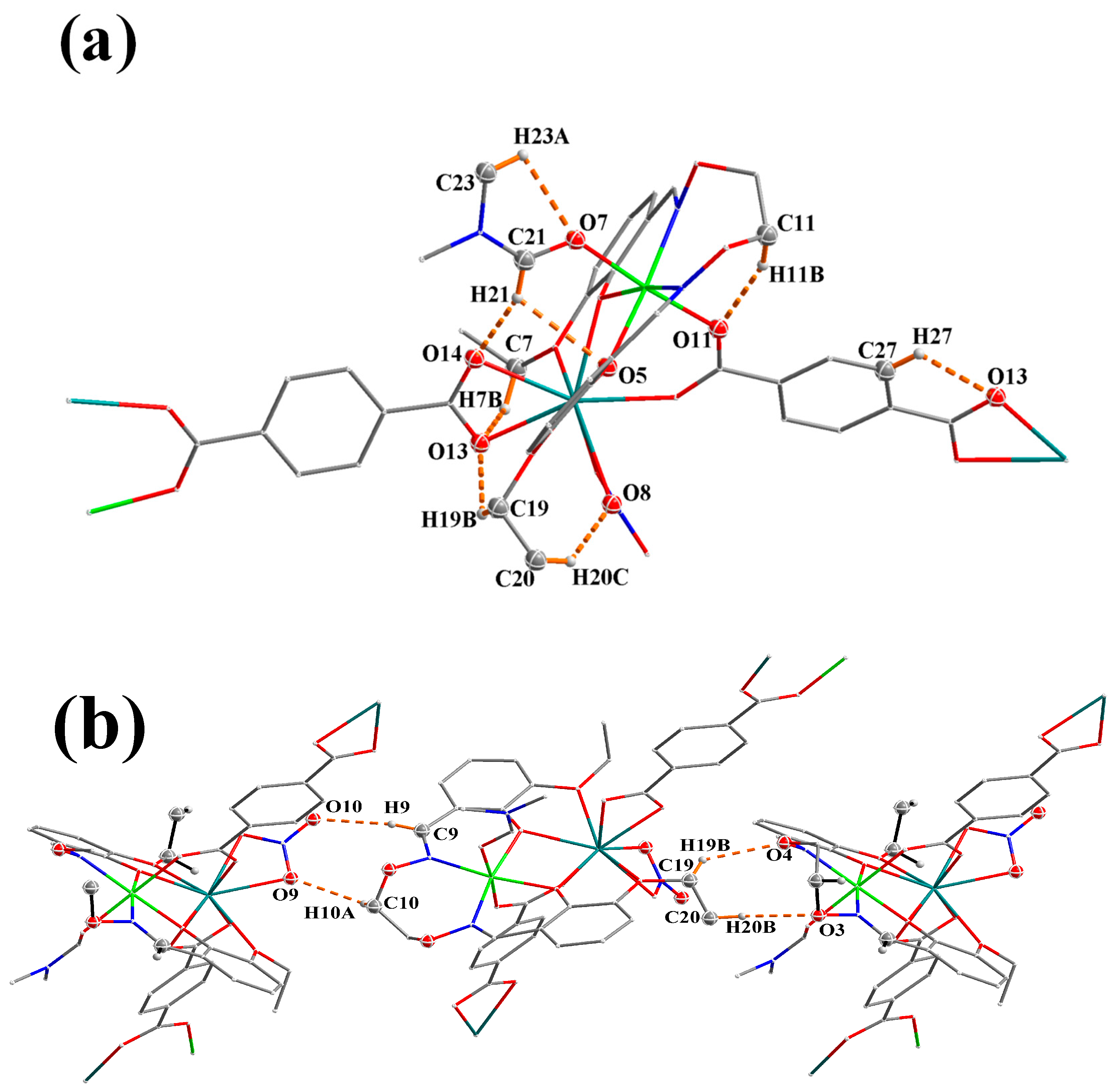
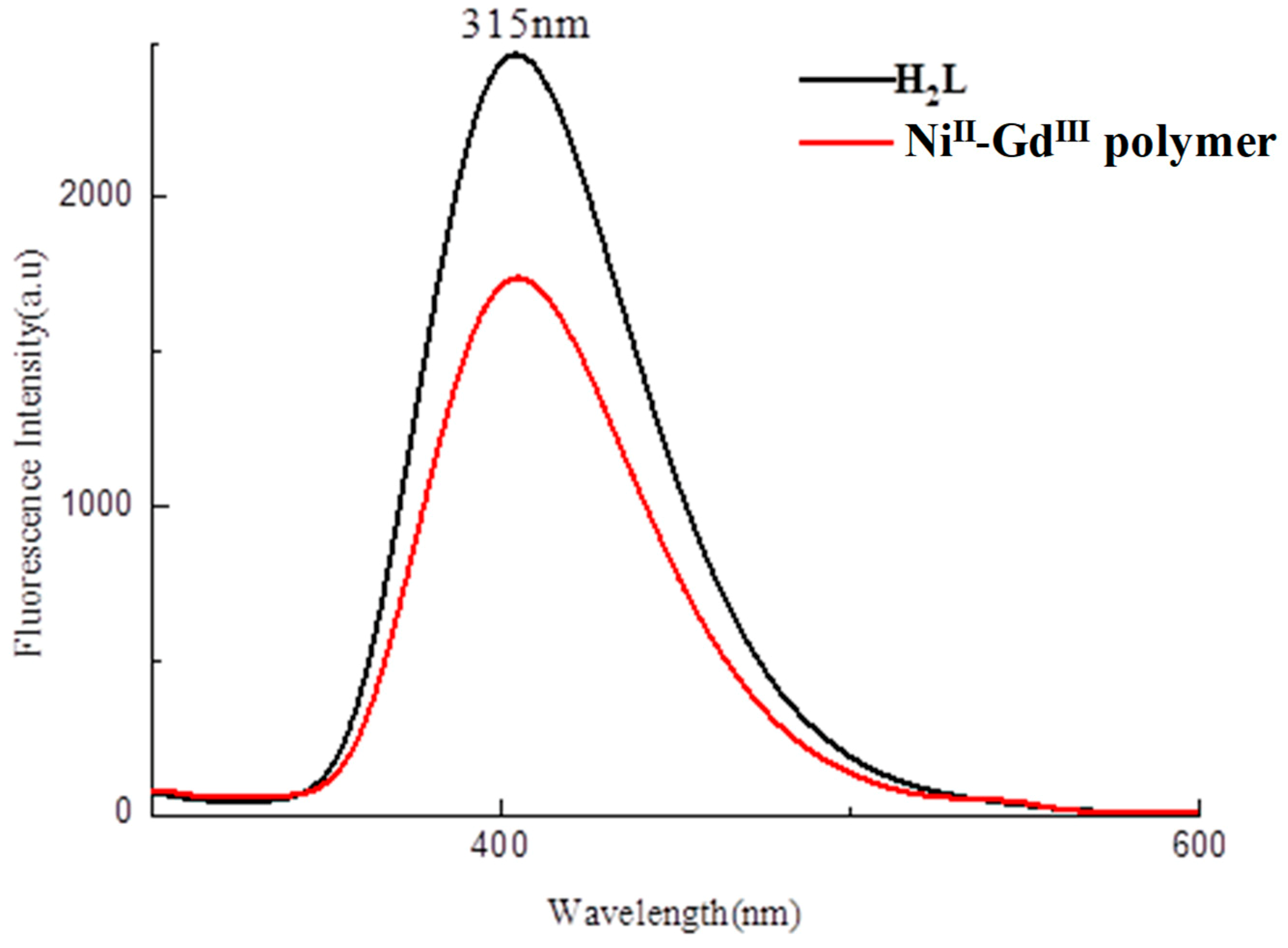
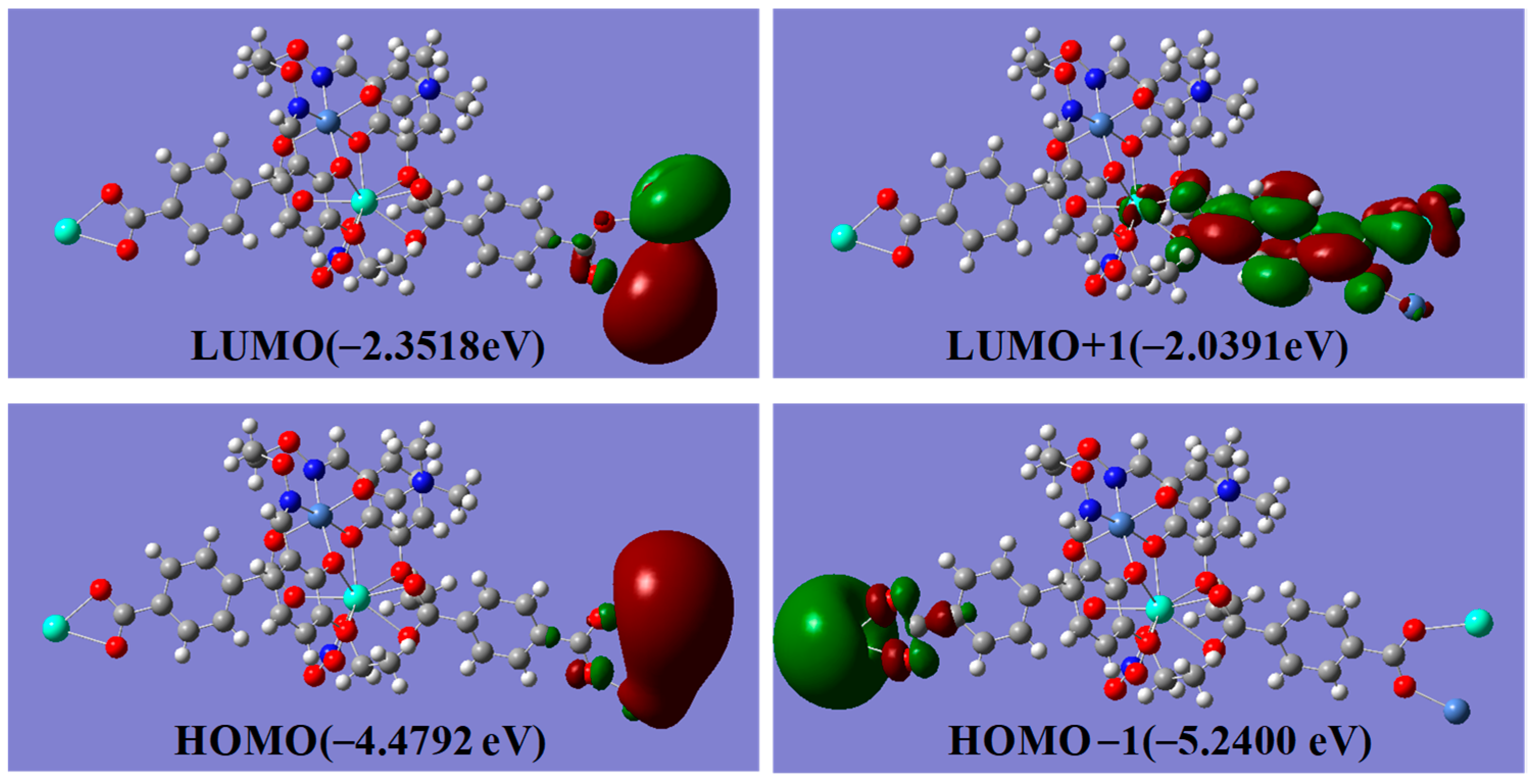

| Compond | The NiII-GdIII Coordination Complex |
|---|---|
| Formula | C31H33GdN4NiO14 |
| Formula weight | 901.57 |
| Temperature (K) | 100.00(10) |
| Radiation (Å) | 0.71073 |
| Crystal system | monoclinic |
| Space group | P 21/n |
| a (Å) | 10.8324 (7) |
| b (Å) | 18.4853 (11) |
| c (Å) | 17.7452 (12) |
| α (°) | 90 |
| β (°) | 104.790 (7) |
| γ (°) | 90 |
| V (Å3) | 3435.6 (4) |
| Z | 4 |
| Dc (g·cm−3) | 1.743 |
| μ (mm−1) | 2.536 |
| F (000) | 1804 |
| Crystal size (mm) | 0.11 × 0.09 × 0.08 |
| θ Range (°) | 2.203–29.566 |
| Index ranges | −14 ≤ h ≤ 11 −23 ≤ k ≤ 23 −22 ≤ l ≤ 19 |
| Completeness to θ | 84.3% (θ = 25.242) |
| Tot. Date | 18,620 |
| Uniq. Date | 8118 |
| R (int) | 0.0397 |
| Observed Date | 6605 |
| Nref/Npar | 8118/464 |
| GOF | 1.020 |
| R[I/>2σ(I)] | R1 = 0.0396, R2 = 0.0846 |
| Largest diff. peak and hole (e·Å−3) | −0.88, 1.45 |
| Bond | Dist. | Bond | Dist. | Bond | Dist. |
| Gd1–O1 | 2.378(2) | Gd1–O13 #1 | 2.416(3) | Ni1–N1 | 2.063(3) |
| Gd1–O2 | 2.521(3) | Gd1–O14 #1 | 2.482(3) | Ni1–N2 | 2.060(3) |
| Gd1–O5 | 2.336(3) | Ni1–O1 | 2.019(3) | Ni1–O7 | 2.091(3) |
| Gd1–O6 | 2.599(3) | Ni1–O5 | 2.025(2) | Ni1–O11 | 2.063(3) |
| Gd1–O8 | 2.473(3) | Gd1–O9 | 2.520(3) | ||
| Bond | Angles | Bond | Angles | Bond | Angles |
| O1–Gd1–O2 | 63.76(9) | O2–Gd1–O6 | 149.31(10) | O5–Gd1–O12 | 82.51(9) |
| O1–Gd1–O5 | 68.34(8) | O2–Gd1–O8 | 122.89(10) | O5–Gd1–O13 #1 | 131.02(9) |
| O1–Gd1–O6 | 123.24(8) | O2–Gd1–O9 | 71.92(9) | O5–Gd1–O14 #1 | 90.05(9) |
| O1–Gd1–O8 | 145.56(10) | O2–Gd1–O12 | 87.78(10) | O5–Gd1–C31 #1 | 110.41(10) |
| O1–Gd1–O9 | 122.76(9) | O1–Gd1–O13 #1 | 78.28(10) | O7–Ni1–N2 | 86.07(12) |
| O1–Gd1–O12 | 73.76(9) | O1–Gd1–O14 #1 | 80.07(10) | O6–Gd1–O8 | 70.28(10) |
| O1–Gd1–O13 #1 | 126.03(9) | O1–Gd1–C31 #1 | 79.59(11) | O6–Gd1–O9 | 113.51(9) |
| O1–Gd1–O14 #1 | 81.99(9) | O5–Gd1–O6 | 62.21(8) | O6–Gd1–O12 | 122.81(10) |
| O1–Gd1–C31 #1 | 105.41(10) | O5–Gd1–O8 | 98.84(9) | O6–Gd1–O13 #1 | 74.78(10) |
| O2–Gd1–O5 | 131.95(9) | O5–Gd1–O9 | 143.56(9) | O6–Gd1–O14 #1 | 72.24(10) |
| O6–Gd1–C31 #1 | 69.72(11) | O9–Gd1–O13 #1 | 73.97(10) | O13#1–Gd1–31 #1 | 26.98(10) |
| O8–Gd1–O9 | 51.00(10) | O9–Gd1–O14 #1 | 124.44(9) | O14#1–Gd1–31 #1 | 26.72(10) |
| O8–Gd1–O12 | 72.90(10) | O9–Gd1–C31 #1 | 100.01(10) | O1–Ni1–O5 | 81.82(10) |
| O8–Gd1–O13 #1 | 86.97(10) | O12–Gd1–O13 #1 | 143.91(10) | O1–Ni1–O7 | 91.33(10) |
| O8–Gd1–O14 #1 | 131.28(10) | O12–Gd1–O14 #1 | 155.71(10) | O1–Ni1–O11 | 90.02(11) |
| O8–Gd1–C31 #1 | 109.03(11) | O12–Gd1–C31 #1 | 166.02(11) | O1–Ni1–N1 | 89.95(12) |
| O9–Gd1–O12 | 70.06(10) | O13#1–Gd1–14 #1 | 53.60(9) | O1–Ni1–N2 | 169.75(12) |
| O5–Ni1–O7 | 92.62(10) | O7–Ni1–O11 | 175.67(11) | O11–Ni1–N2 | 93.31(12) |
| O5–Ni1–O11 | 91.64(11) | O7–Ni1–N1 | 87.35(12) | N1–Ni1–N2 | 99.83(13) |
| O5–Ni1–N1 | 171.76(12) | O7–Ni1–N2 | 86.07(12) | Gd1 #2–C31–O14 | 62.0(2) |
| O5–Ni1–N2 | 88.39(12) | O11–Ni1–N1 | 88.54(13) | Gd1 #2–C31–C28 | 171.4(3) |
| Gd1 #2–C31–O13 | 59.03(19) | Gd1 #2–O13–C31 | 94.0(2) | Gd1 #2–O13–C31 | 91.3(2) |
| D–H···A | d(D–H) | d(H···A) | d(D···A) | ∠D–H···A | Symmetry Code |
|---|---|---|---|---|---|
| C7–H7B···O13 | 0.97 | 2.55 | 3.163(5) | 121 | –1/2 + x, 1/2–y, 2 + z |
| C9–H9···O10 | 0.93 | 2.56 | 3.456(5) | 163 | 3/2 − x, 1/2+ y, 3/2 − z |
| C10–H10A···O9 | 0.97 | 2.54 | 3.259(6) | 131 | 3/2 − x, 1/2+y, 3/2 − z |
| C11–H11B···O11 | 0.97 | 2.24 | 3.169(5) | 159 | |
| C19–H19B···O4 | 0.97 | 2.50 | 3.105(5) | 120 | 1/2 − x, −1/2 + y,3/2 − z |
| C19–H19B··O13 | 0.97 | 2.47 | 3.146(6) | 128 | –1/2 + x, 1/2 − y, 2 + z |
| C20–H20B···O3 | 0.96 | 2.49 | 3.396(6) | 157 | 1/2 − x, 1/2 + y, 3/2 − z |
| C20–H20C···O8 | 0.96 | 2.41 | 3.185(6) | 138 | |
| C21–H21···O5 | 0.93 | 2.56 | 3.090(4) | 116 | |
| C21–H21···O14 | 0.93 | 2.46 | 2.258(5) | 148 | –1/2 + x, 1/2 − y, 2 + z |
| C23–H23A···O7 | 0.96 | 2.44 | 2.810(5) | 103 | |
| C23–H27···O13 | 0.96 | 2.49 | 2.796(5) | 100 |
© 2019 by the authors. Licensee MDPI, Basel, Switzerland. This article is an open access article distributed under the terms and conditions of the Creative Commons Attribution (CC BY) license (http://creativecommons.org/licenses/by/4.0/).
Share and Cite
Cui, Y.-F.; Zhang, Y.; Xie, K.-F.; Dong, W.-K. A Newly Synthesized Heterobimetallic NiII-GdIII Salamo-BDC-Based Coordination Polymer: Structural Characterization, DFT Calculation, Fluorescent and Antibacterial Properties. Crystals 2019, 9, 596. https://doi.org/10.3390/cryst9110596
Cui Y-F, Zhang Y, Xie K-F, Dong W-K. A Newly Synthesized Heterobimetallic NiII-GdIII Salamo-BDC-Based Coordination Polymer: Structural Characterization, DFT Calculation, Fluorescent and Antibacterial Properties. Crystals. 2019; 9(11):596. https://doi.org/10.3390/cryst9110596
Chicago/Turabian StyleCui, Yong-Fan, Yu Zhang, Ke-Feng Xie, and Wen-Kui Dong. 2019. "A Newly Synthesized Heterobimetallic NiII-GdIII Salamo-BDC-Based Coordination Polymer: Structural Characterization, DFT Calculation, Fluorescent and Antibacterial Properties" Crystals 9, no. 11: 596. https://doi.org/10.3390/cryst9110596






